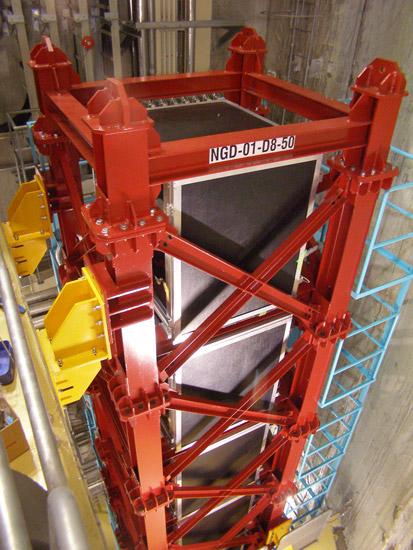As CERN's Large Hadron Collider springs back into action in Europe, success and celebration in particle physics are also being fueled by developments in Asia. Scientists from Japan, Canada, and around the world celebrated this past weekend as they generated elusive neutrino particles and detected them before they began their 300 km traversal of the island of Japan.
Physicists from the Japanese-led multinational Tokai-to-Kamiokande (T2K) neutrino collaboration announced that they detected the first events generated by their newly built neutrino beam at the J-PARC accelerator laboratory in Tokai, Japan. Protons from the Japanese synchrotron were directed onto a carbon target where interactions produce a beam of the elusive particles called neutrinos. These neutrinos then flew 200 metres through the earth to a sophisticated detector system capable of making detailed measurements of their energy, direction, and type.
Akira Konaka, spokesperson for the Canadian team on the project said, "With the discovery of the phenomena of neutrino oscillations from solar neutrinos at SNO in Sudbury, Canada and from cosmic ray neutrinos at Super-Kamiokande in Japan, Japan and Canada are taking the lead in the field of neutrino physics. With the confirmation this weekend that we can produce neutrinos and observe them as planned at J-PARC, we are eager to move on to the physics data-taking phase which involves studying the neutrinos after 300 km rather than just the first 200 metres."
Currently, a dozen students, postdoctoral fellows, and faculty from Canada are staying in Japan to commission and operate the experiment. The beam intensity is rapidly increasing, and the team is making quick progress towards the precision study of neutrino oscillation, providing clues in understanding the origin of mass and mixing of neutrinos.
The data from the complex detector system is still being analyzed, but the physicists have seen at least 3 neutrino events, in line with the expectation based on the current beam and detector performance. Prof.
Koichiro Nishikawa, director of the Institute for Particle and Nuclear physics at the KEK laboratory and founder of the T2K collaboration, said "The T2K experiment is about to reveal another mystery of neutrinos. I would like to thank everyone who has been supporting this experiment directly or indirectly and to thank our excellent collaborators from all over the world for making it possible to reach this stage of the experiment. All the people in T2K also owe a big debt to the accelerator physicists who worked so hard to build and commission the accelerators." This detection marks the beginning of the operational phase of the T2K experiment, a collaboration of a dozen nations and nearly 500 physicists with the aim of measuring new properties of the ghostly neutrino.
Neutrinos interact only weakly with matter, and thus pass effortlessly through the earth. Neutrinos exist in three types, called electron, muon, and tau; linked by particle interactions to their more familiar charged cousins like the electron. Measurements over the last few decades, notably by the Super-Kamiokande and KamLAND neutrino experiments in western Japan and the Sudbury Neutrino Observatory in Ontario, have shown that neutrinos exhibit strange behavior known as neutrino oscillations, whereby one type of neutrino will turn into another as they propagate through space. Neutrino oscillations require neutrinos to have mass and therefore were not allowed in our previous theoretical understanding of particle physics. They may even be related to the mystery of why there is more matter than anti-matter in the universe, and thus are the focus of intense study worldwide.
Canadian scientists have been involved with T2K since its inception and are making key contributions to the experiment which will send a beam of muon neutrinos 300 km across Japan to see how their properties evolve. The Canadian contributions to the T2K beam line include the off-axis beam design concept (a trick to get higher beam intensities at the correct energies), the proton beam transport scheme from the accelerator to the target, and the beam monitoring device which monitors critical properties of the incoming proton beam just before it strikes the target. Also, TRIUMF-based technology was used to provide remote handling systems for the maintenance of the final focus beam monitors, the target, and the horn system.

A photograph of the T2K detector INGRID which observed the neutrinos; each black box is a module.
For more information, please visit the J-PARC webpage.
-- T.I. Meyer, Head of Strategic Planning and Communications [based on joint KEK/J-PARC/TRIUMF press release]
